Winter Audio Reference: On-Board, Consumer, and Pro Solutions
by Derek Wilson on February 3, 2005 12:05 AM EST- Posted in
- Smartphones
- Mobile
Gaming Performance Tests
As game frame rates in modern systems are not heavily impacted by various audio settings, one of the best measures of "goodness" for games will be simply the maximum number and type of hardware buffers that the card supports. Beyond that, the RightMark 3DSound synthetic test can give an indication of what CPU usage will be like in gaming situations. Listed below are the number and type of hardware buffers that each card supports:
Intel HD Audio: 32 buffers 2D, 3D, EAX 2
Gina3G: 128 buffers 2D only
SoundBlaster Audigy 2 ZS PPro: 62 buffers 2D, 3D, EAX 4 Advanced HD
SoundBlaster Audigy 4 Pro: 62 buffers 2D, 3D, EAX 4 Advanced HD
The fact that the Gina3G can open over twice as many DirectSound buffers as the Audigy gives it an advantage in its ability to push audio. But the target is definitely more of a home studio multi-track editing environment rather than a gaming environment. The Gina3G's lack of any 3D accelerated buffer support does make it less of a gaming audio card, as is to be expected. While the Realtek Intel solution provides EAX 2, it's able to provide adequate support for most games on the market.
There are titles out with support for EAX 3 and 4, and they do sound good. Games like Thief 3 and The Chronicles of Riddick make good use of audio to help the gamer actually play the game. Understanding an environment is becoming truly necessary in modern gaming. But we would prefer to see unique personal innovation or the adoption of open standards rather than consumption of proprietary technology.
The RightMark test simulates some normal positional audio effects and internally checks CPU usage every half second. Overall, CPU usage is averaged together at the end of the run. This is the number that we will look at here. Our graphs are broken into multiple series for 16 and 32 buffers, and we've done graphs for the "no audio" case, simple stereo, hardware 3D, and hardware 3D + EAX. Positional audio, in this case, is done via DirectX.
In our tests, we see the Audigy 2 outperforming the Audigy 4 in our DS3D and EAX tests. The Intel solution puts in a good showing as well, though Creative naturally does EAX better. In the 2D realm, the Gina3G doesn't do too poorly either. Note also, that we are talking about percent CPU usage here, so a score of 0.1 is 0.1% of the CPU. The heaviest hitting test comes in at under 5% CPU usage, which just goes to show how little impact even our least efficient HW 3D + EAX implementation has on overall game performance.
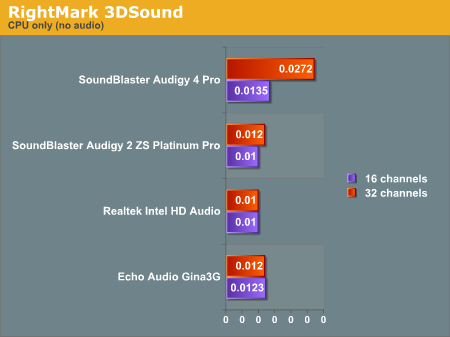
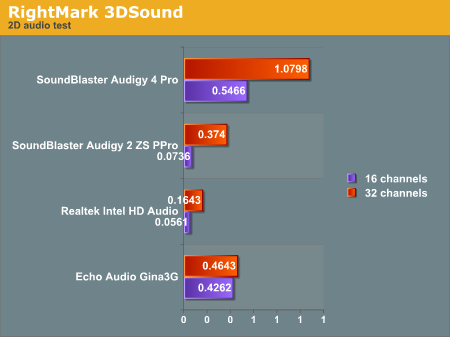
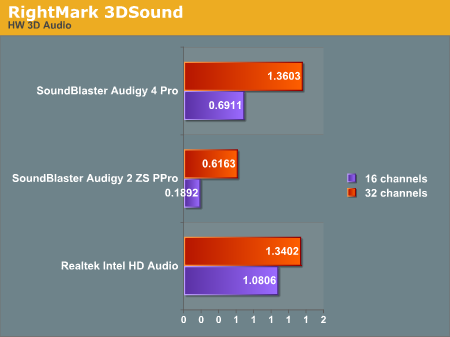
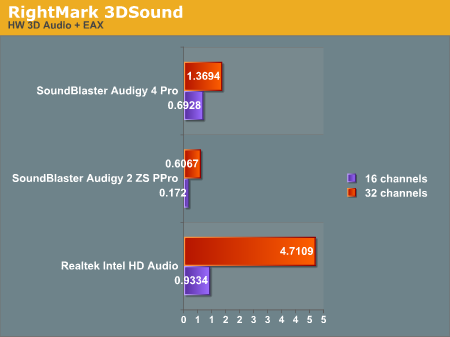
To round out our gaming performance analysis, we'll take a look at Unreal Tournament 2004. All the in-game graphics details were set to "normal" and resolution was set to 800x600. Higher settings pushed the rest of the system too high and drowned out the effect of the audio (as the graphics card became the limiting factor rather than the CPU). Call this artificial if you like, but showing that it takes this much to get a performance delta out of enabling audio is a useful test in and of itself. Especially considering the fact that these differences are bigger than what we saw with Doom 3 no matter what we did.
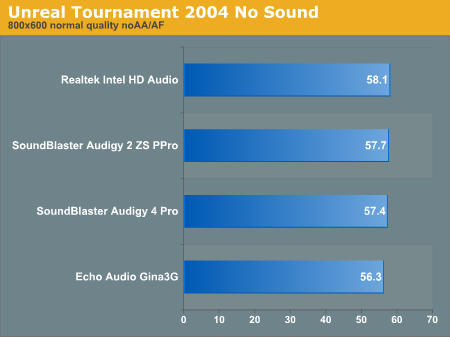
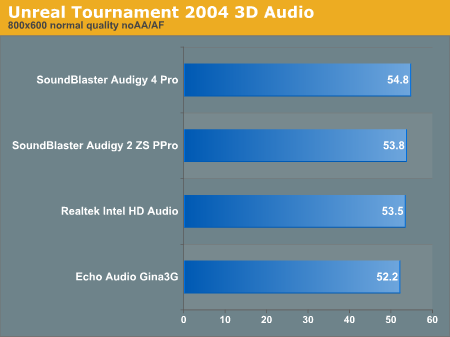
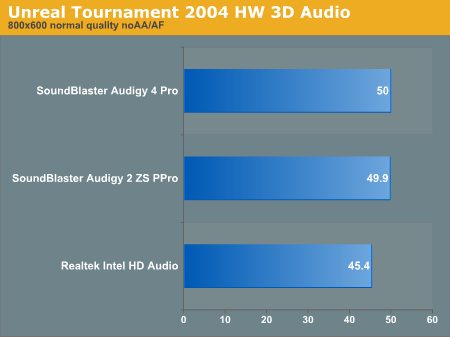
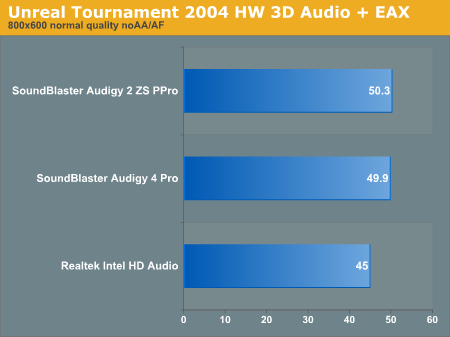










89 Comments
View All Comments
EddNog - Thursday, February 3, 2005 - link
ProviaFan, take a look at the Paradigm stuff, or if you've got decent multichannel power, I also feel that Magnepan's smaller speakers give good sound for the money (MMGs for example). I'm not sure if a Magnepan setup is in your budget (definitely worth the money if you can afford it, though, and comparably cheaper than many other audiophile HT solutions), but Paradigm's midrange (i.e. not Reference series) stuff should be pretty affordable. It's probably no cheaper than Magnepan to outfit your HT with Paradigm Reference, though.Of course there's plenty of other options out there. On the more affordable end, perhaps try some Cambridge Newton Series sats/bookshelves in conjunction with a Velodyne sub.
-Ed
Jigga - Thursday, February 3, 2005 - link
#26 is right on the mark--need ALC850 and Envy24 reviews STAT!ProviaFan - Thursday, February 3, 2005 - link
Response to the audiophile that just posted: Yes, good cable is important, but good cable can be made at home for not terribly large amounts of money... Anything that costs hundreds of dollars per foot is not necessarily bad, but is nonetheless a terrible waste of money, because _there is no difference_. If you hear a difference between a $4 cable and a $40 cable, there probably is a difference. If you hear a difference between a $40 cable and a $4000 cable, it's in your head.With that said, I'd like to know of what to look for in a _good_ 5.1 monitor speaker setup (not consumer gaming quality, but not break-the-bank "audiophile" monitors based advertised with endless pseudoscience), as I might be in the market for something like that. :)
Oh, and if Derek has any extra spare time (yeah, sure ;), I would be interested to see where something like the M-Audio Delta 1010LT sits between the consumer cards and the other pro cards that he mentioned in one of his latest posts (MOTU, Digidesign, etc.).
vaystrem - Thursday, February 3, 2005 - link
Other than Ed I think I'm the only audiophile to post on this and this is my comment regarding your multichannel setup.You used professional monitors for the 2 channel listening, fine Sony isn't great but its ok.
And you used a consumer level speakers, Logitech, for your multichannel experience.
You could hear differences on 2 channel... but not multi channel. What has changed most significantly is... your speakers. As you state, speakers are what introduce the highest levels of distortion.
You can believe me, or not, but on my setup I can hear differences between CD players (Arcam 73t, Cary 308, Creek CD50, Roksan Kandy mkIII, Rega Planet 2000, Cambridge Audio Azur 640c for the curious), cabling and amplifiers.
You need to have better quality speakers for evaulating multichannel. I'm not arguing the speakers are even the most important component, I'm a source first kind of person. But I think that having better evaluatory tools would be helpful.
You absolutely have the right idea of having a 'reference'. Do not change it often. This is something Anandtech has always been good at with your other reviews. You use the same hardware/software tests over a longer period of time than other sites to ensure 'long term comparability'.
Including a subjective element to the tests would be interesting. Some sites to look at.
www.audioasylum.com Post a request on recommended testing methodologies and it might be helpful.
www.uhfmag.com (comparative reviews panel of listeners generally non blind)
www.hifichoice.co.uk (active use of blind listening panels here)
www.stereophile.com www.sixmoons.com
www.soundstage.com (does lots of measurements good comparisons)
Those might be useful.
Also, using some high quality headphones, Sennheiser, Beyerdynamic, Grado might be useful as well.
CSMR - Thursday, February 3, 2005 - link
There is a general ignorance the basics of what audio systems are composed of. A receiver has a completely different purpose to a PC audio card (Griffin powerwave excluded). You need three things: an analog line-level signal (from a DAC), amplification, and speakers. (Exception: digitally-controlled class D amplification.) A $200 receiver will not have as good dacs as those in for instance the EMU 1212m. A receiver is often a DAC and an amplifier. Sound cards generally do not contain amplification.dev0lution - Thursday, February 3, 2005 - link
I second that. While it's nice to know how the audio solutions stack up in testing, some real world advice & comparisons would be a lot more helpful. For example, using the Intel/Realtek onboard solution with quality optical cables straight to a Dolby Digital receiver with home theater speakers versus using an Audigy card to a set of mid-high end 5.1 computer speakers.Zak - Thursday, February 3, 2005 - link
I use SPDIF outputs to hook up my computers to external equipment, a receiver and set of "real" speakers. IMHO a $200 receiver sounds superior to any PC audio card. I get real DolbyDigital and DTS decoding, low CPU overhead. Maybe I miss some of the audio effects in games but I always thought that Creative EAX is way overhyped anyway and most of the time I'd have it turned off because the sound was just plain weird. I think as more games have support for Dolby 5.1 and better EAX will become less relevant.Zak
CSMR - Thursday, February 3, 2005 - link
The review's title should be: audio for gaming. Apart from gaming you have very many audio cards: E-MU, Ego Systems, Edirol, RME, M-Audio, etc.. For audio playback and recording these are the cards to consider; for gaming the reviewed cards are the ones to consider. (Not that they are bad: the Audigy 4 Pro is a good audio card, but around the level of the emu 0404, which costs less.)Slaimus - Thursday, February 3, 2005 - link
Including older cards is a great idea as many people are looking for an upgrade. Something I would like to see included personally:- classic SoundBlaster Live using the kX driver and swapped outputs.
- DFI's Karajan audio module with ALC850 compared to the standard implementation
- SoundBlaster Live 24-bit with the Wolfson DAC
DerekWilson - Thursday, February 3, 2005 - link
#37, bbomb, Good suggestion ...Title changed :-)
I'll add an updated to the conclusion as well that ties together what we were trying to do with the article and explains the point a little better ... I do applogize for the confusion on all this.
For the future, here are some chipsets and cards we want to include in the future:
envy24 boards (maudio and terratec)
realtek alc850 onboard
analog devices onboard
nvidia nf2 soundstorm
pro:
lynx (l22)
emu
digidesign (mbox or digi 002 rack + protools)
motu
rme
It does look like there's a lot of demand for older Turtle Beach and Creative cards, so we'll try to take a look at those as well for reference.